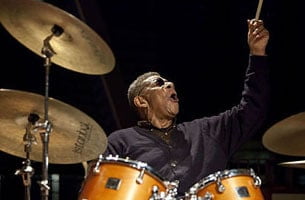Sunny Murray, a jazz drummer and percussionist who perhaps more than any other drummer developed a free approach to the kit, died yesterday in a nursing home outside Paris, according to a spokesman for Eremite Records, a label Murray recorded for. He was 81.
Murray created a drumming style that disposed of timekeeping, concentrating his efforts instead on a barrage of pure sound that both liberated soloists from rhythmic restraint and allowed his instrument to become as musical and textural as those on the frontline.
“I wanted to get more from the beat than just the beat,” he told writer Dan Warburton in 2000. “For me that was like the beginning of a system that I could use to really find my way in what I wanted to play.”
He was best known for his 1960s work with pianist Cecil Taylor and saxophonist Albert Ayler, similarly revolutionary figures in the free-jazz movement. However, Murray also built a substantial career under his own name, performing and recording as a leader for over 50 years.
James Marcellus Arthur Murray was born Sept. 21, 1936, in Idabel, Okla., and grew up in Philadelphia. He moved to New York at 19, hoping to become a drummer despite not being able to afford his own drum set. (He finally acquired one that had been left behind in a police raid of an after-hours spot, he claimed.)
Thus endowed, Murray’s career developed quickly. By 1958 he was working professionally as a bebop drummer with tenor saxophonist Rocky Boyd and sitting in with James Moody, Jackie McLean and Donald Byrd. The following year he became neighbors with Cecil Taylor, and the two began practicing and experimenting together in their Lower Manhattan lofts. It was with Taylor that Murray made his recorded debut, on the 1960 session The World of Cecil Taylor.
It was Taylor, Murray said, who inspired him to liberate the drums from subservience to the beat. “It started to seem like Cecil’s music required more than [that],” he said in a 2003 interview with All About Jazz. “I started to study more acoustical and natural sounds, tones … started dealing with the natural sounds that are in the instrument, and the pulsations that are in that sound.” His sound was never arrhythmic, but it did move into abstraction, often engaging the various drums on his kit in rapid-fire conversations. Murray was also able to generate a remarkable timbral palette with only a very basic kit, seeing no need to augment it with redundant or specialized pieces.
Murray joined Albert Ayler, whom he had met while touring Europe with Taylor, in 1964. His work that year on the saxophonist’s seminal recording Spiritual Unity brought Murray’s innovations into sharper focus, allowing him to record his 1965 debut, Sonny’s Time Now, for the fledgling label ESP-Disk’. From that point he became a more frequent bandleader, working more frequently still after his move to Paris in 1968. He returned to New York a few years later and worked steadily, collaborating through the ’70s and ’80s with saxophonists Byard Lancaster and David Murray, bassist William Parker and vibraphonist Khan Jamal before moving back to Europe in the mid-’90s.
In his last performing years, Murray worked primarily with a London-based trio featuring saxophonist Tony Bevan and bassist John Edwards, which found him as restless and experimental as ever. Yet Murray insisted he was no iconoclast, but firmly a part of the jazz tradition. “I’m proud to be a jazz musician,” he said in Jason Weiss’ 2012 book Always in Trouble: The Oral History of ESP Disk’, the Most Outrageous Record Label in America. “You have to be proud of having this history.”







More Stories
CD review: George Benson – Dreams Do Come True: When George Benson Meets Robert Farnon – 2024: Video, CD cover
The band was tight as ever. The Warren Haynes Band cuts loose: Video, Photos
Interview with Alvin Queen: Feeling Good – I heard these tunes played by … Video, new CD cover, Photos